Clinical Reasoning Cycle Application: A Case Study in Nursing Practice
VerifiedAdded on 2022/10/10
|11
|2643
|30
Case Study
AI Summary
This case study assignment analyzes a 28-year-old male patient presenting with symptoms indicative of diabetic ketoacidosis (DKA), including nausea, vomiting, and polydipsia. The assignment utilizes the Clinical Reasoning Cycle to assess the patient's subjective and objective data, including vital signs, blood glucose levels, and electrolyte imbalances. The student identifies three nursing priorities: improving electrolyte balance, managing insulin deficiency, and adjusting the patient's diet. Interventions such as Hartman's solution, insulin infusion, and a low-protein diet are proposed. The evaluation focuses on monitoring electrolyte levels, blood glucose, and the patient's overall response to the interventions. The assignment concludes with a reflection on the learning experience and the application of the Clinical Reasoning Cycle in nursing practice, highlighting the importance of evidence-based care and critical thinking in managing DKA and similar conditions. The case study adheres to ethical, legal, and holistic person-centered care principles, establishing realistic and relevant goals throughout the process, as per the assignment brief.
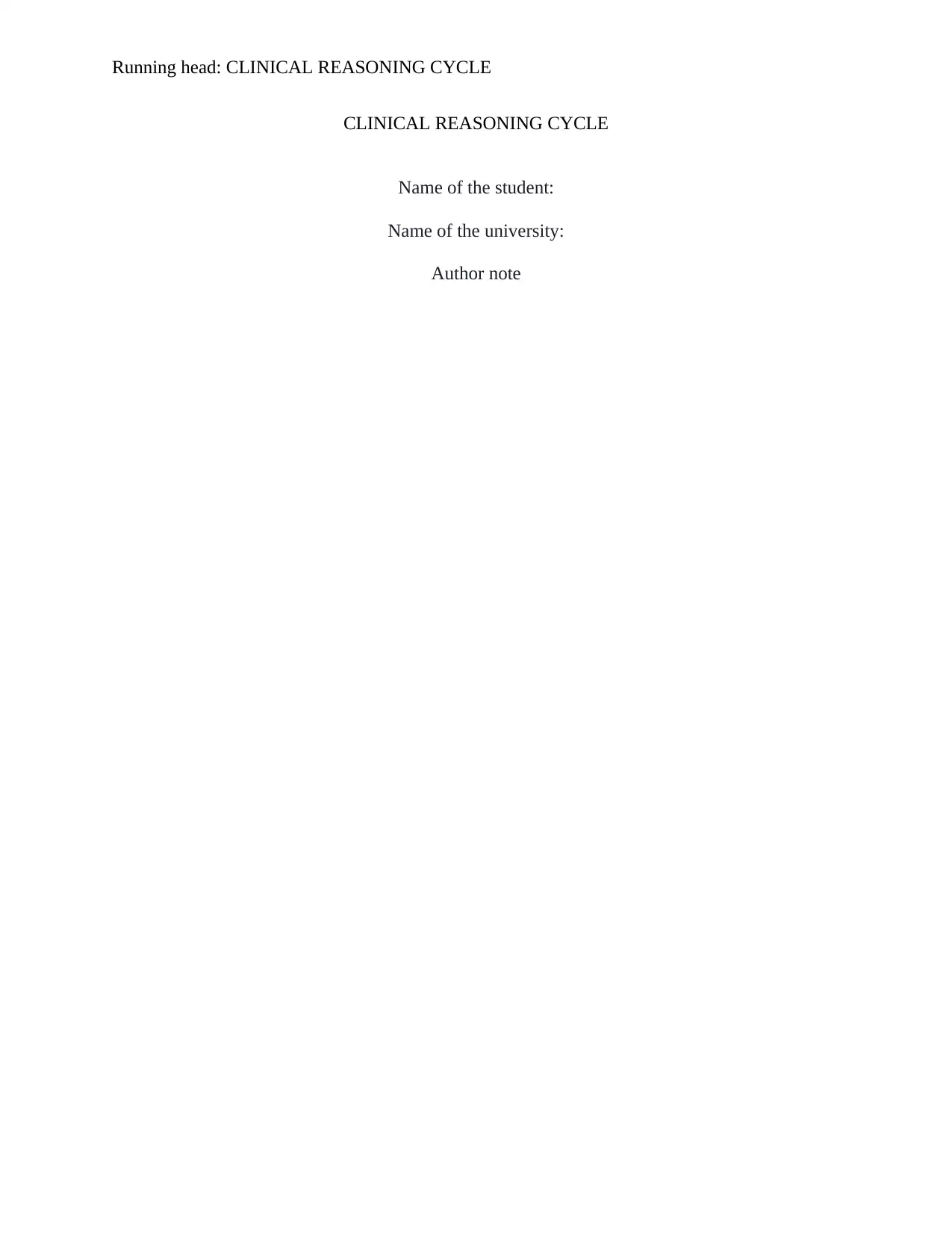
Running head: CLINICAL REASONING CYCLE
CLINICAL REASONING CYCLE
Name of the student:
Name of the university:
Author note
CLINICAL REASONING CYCLE
Name of the student:
Name of the university:
Author note
Paraphrase This Document
Need a fresh take? Get an instant paraphrase of this document with our AI Paraphraser
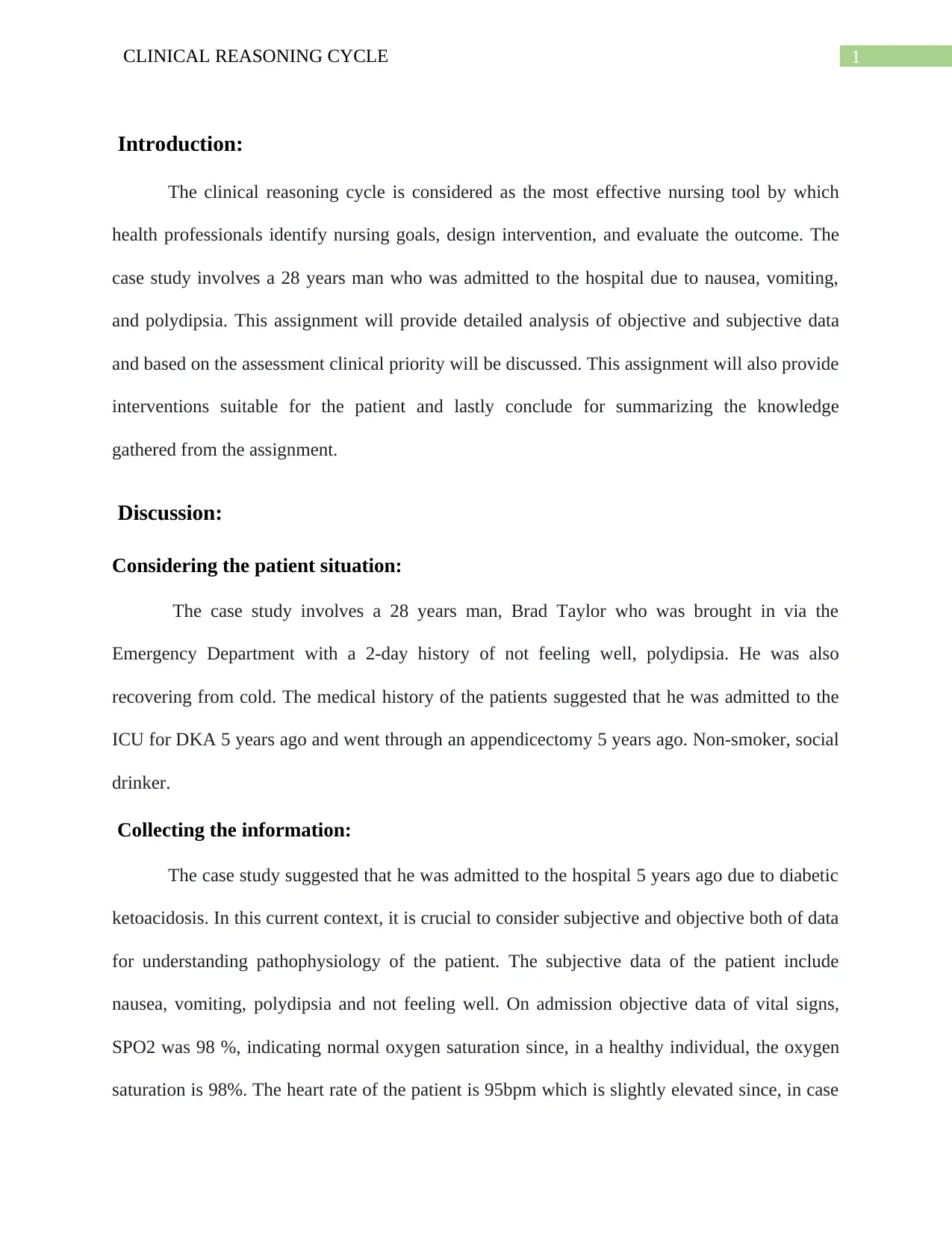
1CLINICAL REASONING CYCLE
Introduction:
The clinical reasoning cycle is considered as the most effective nursing tool by which
health professionals identify nursing goals, design intervention, and evaluate the outcome. The
case study involves a 28 years man who was admitted to the hospital due to nausea, vomiting,
and polydipsia. This assignment will provide detailed analysis of objective and subjective data
and based on the assessment clinical priority will be discussed. This assignment will also provide
interventions suitable for the patient and lastly conclude for summarizing the knowledge
gathered from the assignment.
Discussion:
Considering the patient situation:
The case study involves a 28 years man, Brad Taylor who was brought in via the
Emergency Department with a 2-day history of not feeling well, polydipsia. He was also
recovering from cold. The medical history of the patients suggested that he was admitted to the
ICU for DKA 5 years ago and went through an appendicectomy 5 years ago. Non-smoker, social
drinker.
Collecting the information:
The case study suggested that he was admitted to the hospital 5 years ago due to diabetic
ketoacidosis. In this current context, it is crucial to consider subjective and objective both of data
for understanding pathophysiology of the patient. The subjective data of the patient include
nausea, vomiting, polydipsia and not feeling well. On admission objective data of vital signs,
SPO2 was 98 %, indicating normal oxygen saturation since, in a healthy individual, the oxygen
saturation is 98%. The heart rate of the patient is 95bpm which is slightly elevated since, in case
Introduction:
The clinical reasoning cycle is considered as the most effective nursing tool by which
health professionals identify nursing goals, design intervention, and evaluate the outcome. The
case study involves a 28 years man who was admitted to the hospital due to nausea, vomiting,
and polydipsia. This assignment will provide detailed analysis of objective and subjective data
and based on the assessment clinical priority will be discussed. This assignment will also provide
interventions suitable for the patient and lastly conclude for summarizing the knowledge
gathered from the assignment.
Discussion:
Considering the patient situation:
The case study involves a 28 years man, Brad Taylor who was brought in via the
Emergency Department with a 2-day history of not feeling well, polydipsia. He was also
recovering from cold. The medical history of the patients suggested that he was admitted to the
ICU for DKA 5 years ago and went through an appendicectomy 5 years ago. Non-smoker, social
drinker.
Collecting the information:
The case study suggested that he was admitted to the hospital 5 years ago due to diabetic
ketoacidosis. In this current context, it is crucial to consider subjective and objective both of data
for understanding pathophysiology of the patient. The subjective data of the patient include
nausea, vomiting, polydipsia and not feeling well. On admission objective data of vital signs,
SPO2 was 98 %, indicating normal oxygen saturation since, in a healthy individual, the oxygen
saturation is 98%. The heart rate of the patient is 95bpm which is slightly elevated since, in case
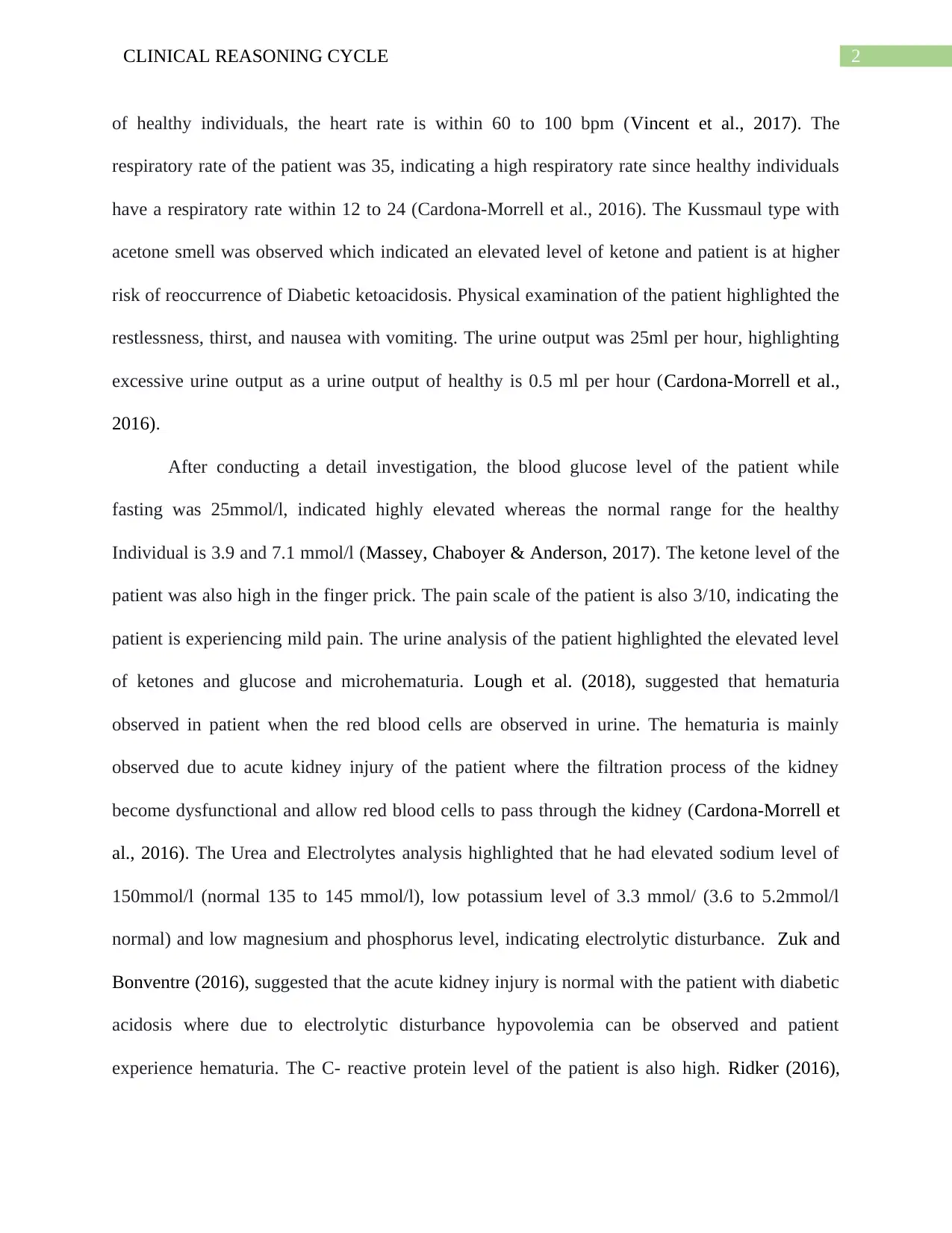
2CLINICAL REASONING CYCLE
of healthy individuals, the heart rate is within 60 to 100 bpm (Vincent et al., 2017). The
respiratory rate of the patient was 35, indicating a high respiratory rate since healthy individuals
have a respiratory rate within 12 to 24 (Cardona-Morrell et al., 2016). The Kussmaul type with
acetone smell was observed which indicated an elevated level of ketone and patient is at higher
risk of reoccurrence of Diabetic ketoacidosis. Physical examination of the patient highlighted the
restlessness, thirst, and nausea with vomiting. The urine output was 25ml per hour, highlighting
excessive urine output as a urine output of healthy is 0.5 ml per hour (Cardona‐Morrell et al.,
2016).
After conducting a detail investigation, the blood glucose level of the patient while
fasting was 25mmol/l, indicated highly elevated whereas the normal range for the healthy
Individual is 3.9 and 7.1 mmol/l (Massey, Chaboyer & Anderson, 2017). The ketone level of the
patient was also high in the finger prick. The pain scale of the patient is also 3/10, indicating the
patient is experiencing mild pain. The urine analysis of the patient highlighted the elevated level
of ketones and glucose and microhematuria. Lough et al. (2018), suggested that hematuria
observed in patient when the red blood cells are observed in urine. The hematuria is mainly
observed due to acute kidney injury of the patient where the filtration process of the kidney
become dysfunctional and allow red blood cells to pass through the kidney (Cardona‐Morrell et
al., 2016). The Urea and Electrolytes analysis highlighted that he had elevated sodium level of
150mmol/l (normal 135 to 145 mmol/l), low potassium level of 3.3 mmol/ (3.6 to 5.2mmol/l
normal) and low magnesium and phosphorus level, indicating electrolytic disturbance. Zuk and
Bonventre (2016), suggested that the acute kidney injury is normal with the patient with diabetic
acidosis where due to electrolytic disturbance hypovolemia can be observed and patient
experience hematuria. The C- reactive protein level of the patient is also high. Ridker (2016),
of healthy individuals, the heart rate is within 60 to 100 bpm (Vincent et al., 2017). The
respiratory rate of the patient was 35, indicating a high respiratory rate since healthy individuals
have a respiratory rate within 12 to 24 (Cardona-Morrell et al., 2016). The Kussmaul type with
acetone smell was observed which indicated an elevated level of ketone and patient is at higher
risk of reoccurrence of Diabetic ketoacidosis. Physical examination of the patient highlighted the
restlessness, thirst, and nausea with vomiting. The urine output was 25ml per hour, highlighting
excessive urine output as a urine output of healthy is 0.5 ml per hour (Cardona‐Morrell et al.,
2016).
After conducting a detail investigation, the blood glucose level of the patient while
fasting was 25mmol/l, indicated highly elevated whereas the normal range for the healthy
Individual is 3.9 and 7.1 mmol/l (Massey, Chaboyer & Anderson, 2017). The ketone level of the
patient was also high in the finger prick. The pain scale of the patient is also 3/10, indicating the
patient is experiencing mild pain. The urine analysis of the patient highlighted the elevated level
of ketones and glucose and microhematuria. Lough et al. (2018), suggested that hematuria
observed in patient when the red blood cells are observed in urine. The hematuria is mainly
observed due to acute kidney injury of the patient where the filtration process of the kidney
become dysfunctional and allow red blood cells to pass through the kidney (Cardona‐Morrell et
al., 2016). The Urea and Electrolytes analysis highlighted that he had elevated sodium level of
150mmol/l (normal 135 to 145 mmol/l), low potassium level of 3.3 mmol/ (3.6 to 5.2mmol/l
normal) and low magnesium and phosphorus level, indicating electrolytic disturbance. Zuk and
Bonventre (2016), suggested that the acute kidney injury is normal with the patient with diabetic
acidosis where due to electrolytic disturbance hypovolemia can be observed and patient
experience hematuria. The C- reactive protein level of the patient is also high. Ridker (2016),
⊘ This is a preview!⊘
Do you want full access?
Subscribe today to unlock all pages.

Trusted by 1+ million students worldwide
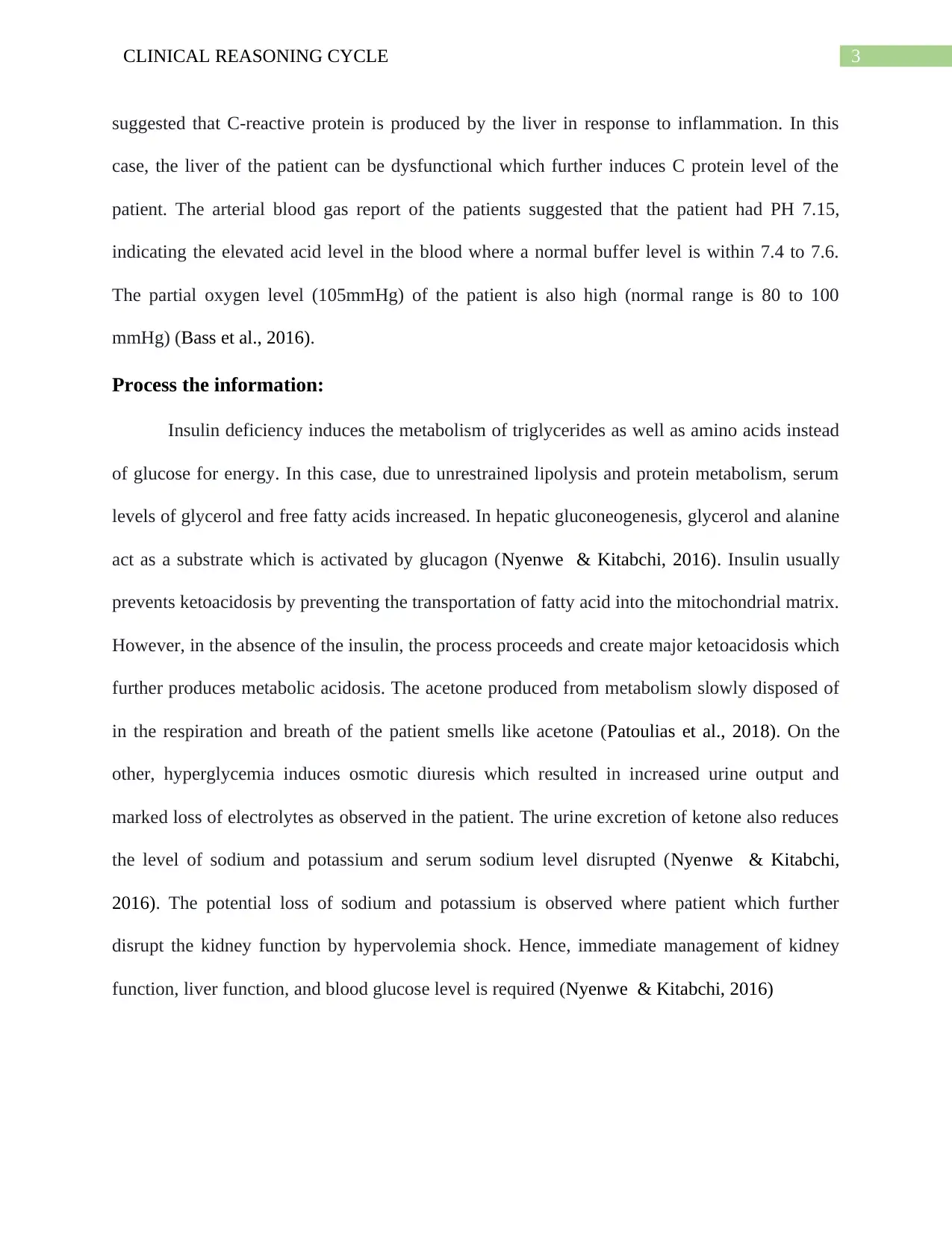
3CLINICAL REASONING CYCLE
suggested that C-reactive protein is produced by the liver in response to inflammation. In this
case, the liver of the patient can be dysfunctional which further induces C protein level of the
patient. The arterial blood gas report of the patients suggested that the patient had PH 7.15,
indicating the elevated acid level in the blood where a normal buffer level is within 7.4 to 7.6.
The partial oxygen level (105mmHg) of the patient is also high (normal range is 80 to 100
mmHg) (Bass et al., 2016).
Process the information:
Insulin deficiency induces the metabolism of triglycerides as well as amino acids instead
of glucose for energy. In this case, due to unrestrained lipolysis and protein metabolism, serum
levels of glycerol and free fatty acids increased. In hepatic gluconeogenesis, glycerol and alanine
act as a substrate which is activated by glucagon (Nyenwe & Kitabchi, 2016). Insulin usually
prevents ketoacidosis by preventing the transportation of fatty acid into the mitochondrial matrix.
However, in the absence of the insulin, the process proceeds and create major ketoacidosis which
further produces metabolic acidosis. The acetone produced from metabolism slowly disposed of
in the respiration and breath of the patient smells like acetone (Patoulias et al., 2018). On the
other, hyperglycemia induces osmotic diuresis which resulted in increased urine output and
marked loss of electrolytes as observed in the patient. The urine excretion of ketone also reduces
the level of sodium and potassium and serum sodium level disrupted (Nyenwe & Kitabchi,
2016). The potential loss of sodium and potassium is observed where patient which further
disrupt the kidney function by hypervolemia shock. Hence, immediate management of kidney
function, liver function, and blood glucose level is required (Nyenwe & Kitabchi, 2016)
suggested that C-reactive protein is produced by the liver in response to inflammation. In this
case, the liver of the patient can be dysfunctional which further induces C protein level of the
patient. The arterial blood gas report of the patients suggested that the patient had PH 7.15,
indicating the elevated acid level in the blood where a normal buffer level is within 7.4 to 7.6.
The partial oxygen level (105mmHg) of the patient is also high (normal range is 80 to 100
mmHg) (Bass et al., 2016).
Process the information:
Insulin deficiency induces the metabolism of triglycerides as well as amino acids instead
of glucose for energy. In this case, due to unrestrained lipolysis and protein metabolism, serum
levels of glycerol and free fatty acids increased. In hepatic gluconeogenesis, glycerol and alanine
act as a substrate which is activated by glucagon (Nyenwe & Kitabchi, 2016). Insulin usually
prevents ketoacidosis by preventing the transportation of fatty acid into the mitochondrial matrix.
However, in the absence of the insulin, the process proceeds and create major ketoacidosis which
further produces metabolic acidosis. The acetone produced from metabolism slowly disposed of
in the respiration and breath of the patient smells like acetone (Patoulias et al., 2018). On the
other, hyperglycemia induces osmotic diuresis which resulted in increased urine output and
marked loss of electrolytes as observed in the patient. The urine excretion of ketone also reduces
the level of sodium and potassium and serum sodium level disrupted (Nyenwe & Kitabchi,
2016). The potential loss of sodium and potassium is observed where patient which further
disrupt the kidney function by hypervolemia shock. Hence, immediate management of kidney
function, liver function, and blood glucose level is required (Nyenwe & Kitabchi, 2016)
Paraphrase This Document
Need a fresh take? Get an instant paraphrase of this document with our AI Paraphraser
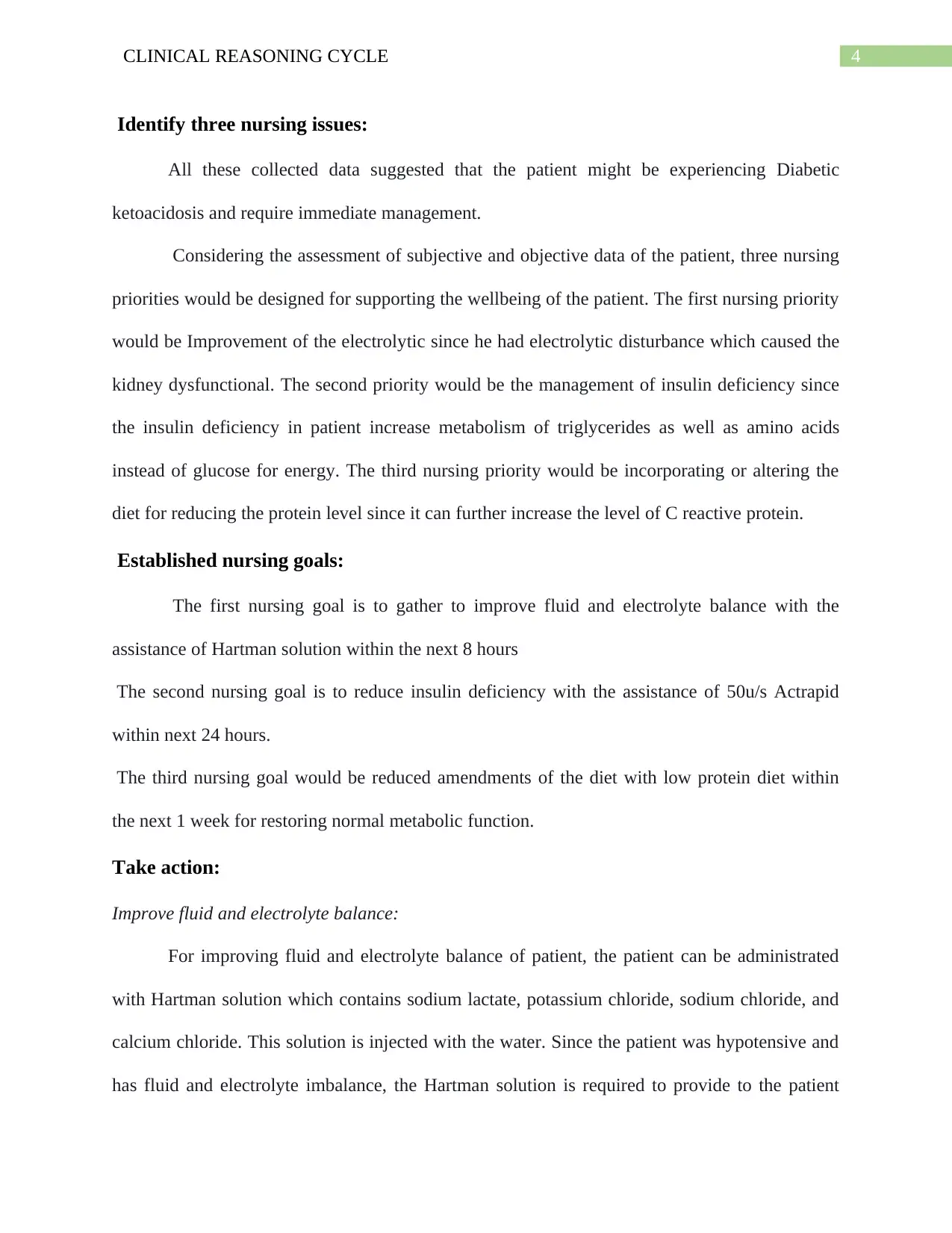
4CLINICAL REASONING CYCLE
Identify three nursing issues:
All these collected data suggested that the patient might be experiencing Diabetic
ketoacidosis and require immediate management.
Considering the assessment of subjective and objective data of the patient, three nursing
priorities would be designed for supporting the wellbeing of the patient. The first nursing priority
would be Improvement of the electrolytic since he had electrolytic disturbance which caused the
kidney dysfunctional. The second priority would be the management of insulin deficiency since
the insulin deficiency in patient increase metabolism of triglycerides as well as amino acids
instead of glucose for energy. The third nursing priority would be incorporating or altering the
diet for reducing the protein level since it can further increase the level of C reactive protein.
Established nursing goals:
The first nursing goal is to gather to improve fluid and electrolyte balance with the
assistance of Hartman solution within the next 8 hours
The second nursing goal is to reduce insulin deficiency with the assistance of 50u/s Actrapid
within next 24 hours.
The third nursing goal would be reduced amendments of the diet with low protein diet within
the next 1 week for restoring normal metabolic function.
Take action:
Improve fluid and electrolyte balance:
For improving fluid and electrolyte balance of patient, the patient can be administrated
with Hartman solution which contains sodium lactate, potassium chloride, sodium chloride, and
calcium chloride. This solution is injected with the water. Since the patient was hypotensive and
has fluid and electrolyte imbalance, the Hartman solution is required to provide to the patient
Identify three nursing issues:
All these collected data suggested that the patient might be experiencing Diabetic
ketoacidosis and require immediate management.
Considering the assessment of subjective and objective data of the patient, three nursing
priorities would be designed for supporting the wellbeing of the patient. The first nursing priority
would be Improvement of the electrolytic since he had electrolytic disturbance which caused the
kidney dysfunctional. The second priority would be the management of insulin deficiency since
the insulin deficiency in patient increase metabolism of triglycerides as well as amino acids
instead of glucose for energy. The third nursing priority would be incorporating or altering the
diet for reducing the protein level since it can further increase the level of C reactive protein.
Established nursing goals:
The first nursing goal is to gather to improve fluid and electrolyte balance with the
assistance of Hartman solution within the next 8 hours
The second nursing goal is to reduce insulin deficiency with the assistance of 50u/s Actrapid
within next 24 hours.
The third nursing goal would be reduced amendments of the diet with low protein diet within
the next 1 week for restoring normal metabolic function.
Take action:
Improve fluid and electrolyte balance:
For improving fluid and electrolyte balance of patient, the patient can be administrated
with Hartman solution which contains sodium lactate, potassium chloride, sodium chloride, and
calcium chloride. This solution is injected with the water. Since the patient was hypotensive and
has fluid and electrolyte imbalance, the Hartman solution is required to provide to the patient
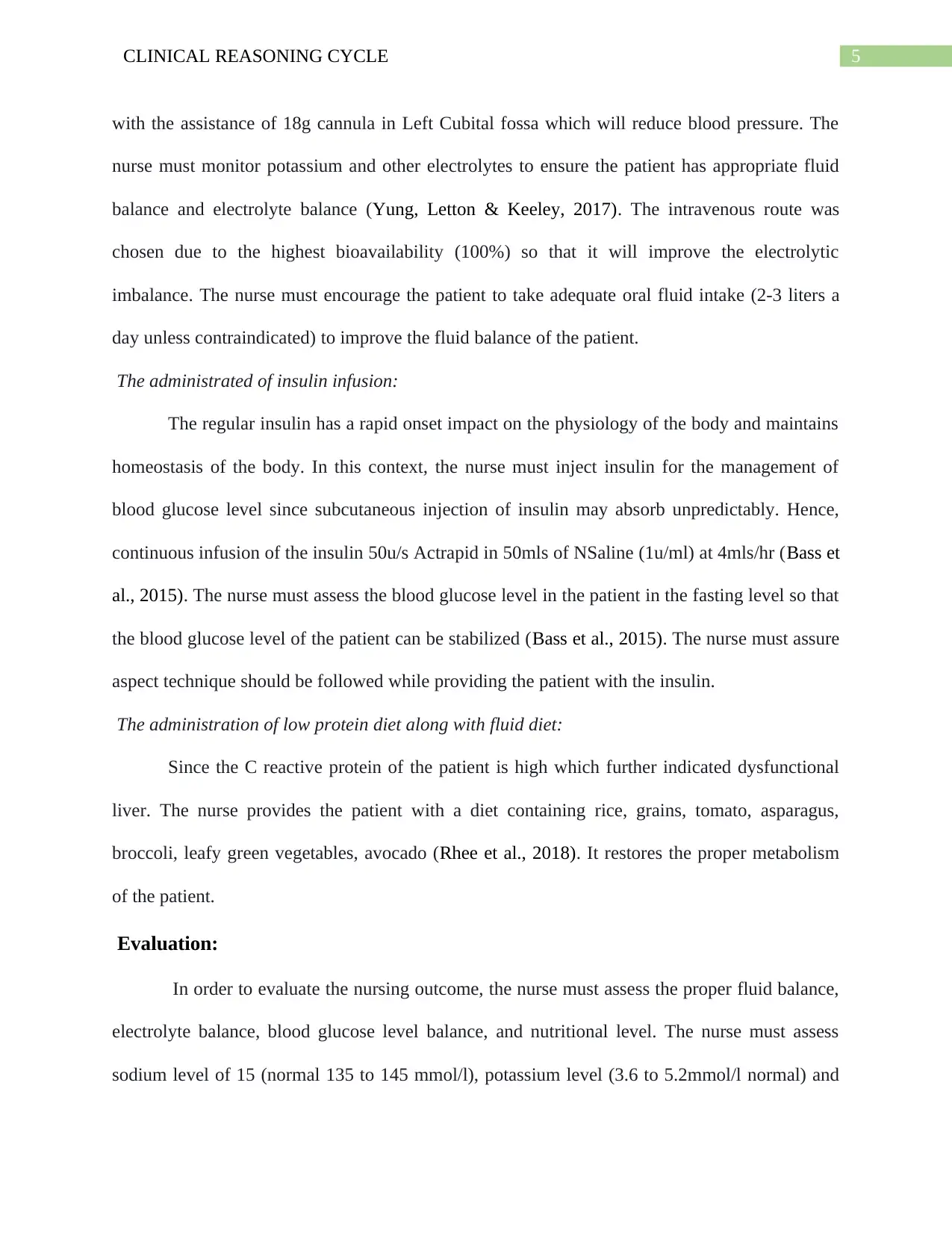
5CLINICAL REASONING CYCLE
with the assistance of 18g cannula in Left Cubital fossa which will reduce blood pressure. The
nurse must monitor potassium and other electrolytes to ensure the patient has appropriate fluid
balance and electrolyte balance (Yung, Letton & Keeley, 2017). The intravenous route was
chosen due to the highest bioavailability (100%) so that it will improve the electrolytic
imbalance. The nurse must encourage the patient to take adequate oral fluid intake (2-3 liters a
day unless contraindicated) to improve the fluid balance of the patient.
The administrated of insulin infusion:
The regular insulin has a rapid onset impact on the physiology of the body and maintains
homeostasis of the body. In this context, the nurse must inject insulin for the management of
blood glucose level since subcutaneous injection of insulin may absorb unpredictably. Hence,
continuous infusion of the insulin 50u/s Actrapid in 50mls of NSaline (1u/ml) at 4mls/hr (Bass et
al., 2015). The nurse must assess the blood glucose level in the patient in the fasting level so that
the blood glucose level of the patient can be stabilized (Bass et al., 2015). The nurse must assure
aspect technique should be followed while providing the patient with the insulin.
The administration of low protein diet along with fluid diet:
Since the C reactive protein of the patient is high which further indicated dysfunctional
liver. The nurse provides the patient with a diet containing rice, grains, tomato, asparagus,
broccoli, leafy green vegetables, avocado (Rhee et al., 2018). It restores the proper metabolism
of the patient.
Evaluation:
In order to evaluate the nursing outcome, the nurse must assess the proper fluid balance,
electrolyte balance, blood glucose level balance, and nutritional level. The nurse must assess
sodium level of 15 (normal 135 to 145 mmol/l), potassium level (3.6 to 5.2mmol/l normal) and
with the assistance of 18g cannula in Left Cubital fossa which will reduce blood pressure. The
nurse must monitor potassium and other electrolytes to ensure the patient has appropriate fluid
balance and electrolyte balance (Yung, Letton & Keeley, 2017). The intravenous route was
chosen due to the highest bioavailability (100%) so that it will improve the electrolytic
imbalance. The nurse must encourage the patient to take adequate oral fluid intake (2-3 liters a
day unless contraindicated) to improve the fluid balance of the patient.
The administrated of insulin infusion:
The regular insulin has a rapid onset impact on the physiology of the body and maintains
homeostasis of the body. In this context, the nurse must inject insulin for the management of
blood glucose level since subcutaneous injection of insulin may absorb unpredictably. Hence,
continuous infusion of the insulin 50u/s Actrapid in 50mls of NSaline (1u/ml) at 4mls/hr (Bass et
al., 2015). The nurse must assess the blood glucose level in the patient in the fasting level so that
the blood glucose level of the patient can be stabilized (Bass et al., 2015). The nurse must assure
aspect technique should be followed while providing the patient with the insulin.
The administration of low protein diet along with fluid diet:
Since the C reactive protein of the patient is high which further indicated dysfunctional
liver. The nurse provides the patient with a diet containing rice, grains, tomato, asparagus,
broccoli, leafy green vegetables, avocado (Rhee et al., 2018). It restores the proper metabolism
of the patient.
Evaluation:
In order to evaluate the nursing outcome, the nurse must assess the proper fluid balance,
electrolyte balance, blood glucose level balance, and nutritional level. The nurse must assess
sodium level of 15 (normal 135 to 145 mmol/l), potassium level (3.6 to 5.2mmol/l normal) and
⊘ This is a preview!⊘
Do you want full access?
Subscribe today to unlock all pages.

Trusted by 1+ million students worldwide
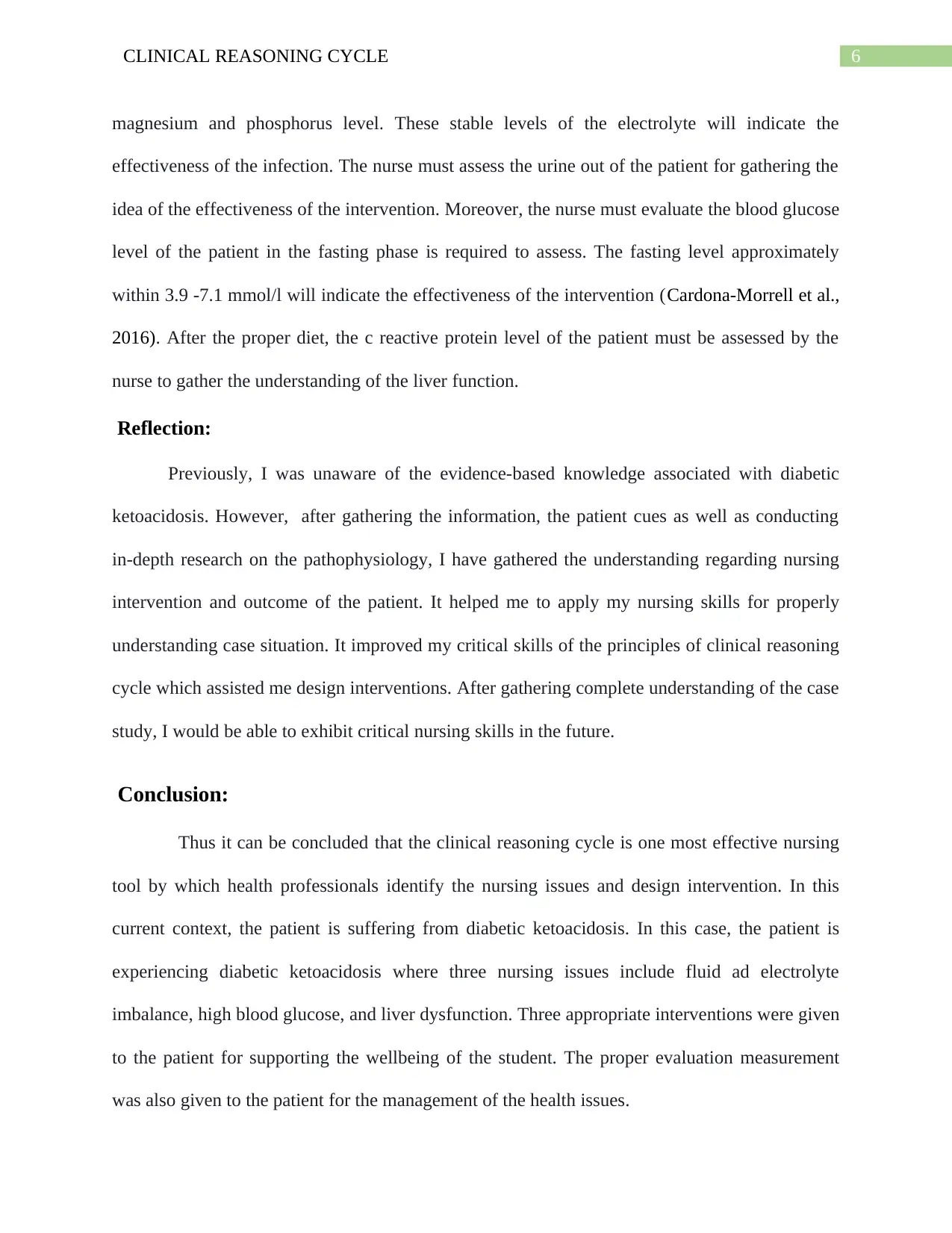
6CLINICAL REASONING CYCLE
magnesium and phosphorus level. These stable levels of the electrolyte will indicate the
effectiveness of the infection. The nurse must assess the urine out of the patient for gathering the
idea of the effectiveness of the intervention. Moreover, the nurse must evaluate the blood glucose
level of the patient in the fasting phase is required to assess. The fasting level approximately
within 3.9 -7.1 mmol/l will indicate the effectiveness of the intervention (Cardona‐Morrell et al.,
2016). After the proper diet, the c reactive protein level of the patient must be assessed by the
nurse to gather the understanding of the liver function.
Reflection:
Previously, I was unaware of the evidence-based knowledge associated with diabetic
ketoacidosis. However, after gathering the information, the patient cues as well as conducting
in-depth research on the pathophysiology, I have gathered the understanding regarding nursing
intervention and outcome of the patient. It helped me to apply my nursing skills for properly
understanding case situation. It improved my critical skills of the principles of clinical reasoning
cycle which assisted me design interventions. After gathering complete understanding of the case
study, I would be able to exhibit critical nursing skills in the future.
Conclusion:
Thus it can be concluded that the clinical reasoning cycle is one most effective nursing
tool by which health professionals identify the nursing issues and design intervention. In this
current context, the patient is suffering from diabetic ketoacidosis. In this case, the patient is
experiencing diabetic ketoacidosis where three nursing issues include fluid ad electrolyte
imbalance, high blood glucose, and liver dysfunction. Three appropriate interventions were given
to the patient for supporting the wellbeing of the student. The proper evaluation measurement
was also given to the patient for the management of the health issues.
magnesium and phosphorus level. These stable levels of the electrolyte will indicate the
effectiveness of the infection. The nurse must assess the urine out of the patient for gathering the
idea of the effectiveness of the intervention. Moreover, the nurse must evaluate the blood glucose
level of the patient in the fasting phase is required to assess. The fasting level approximately
within 3.9 -7.1 mmol/l will indicate the effectiveness of the intervention (Cardona‐Morrell et al.,
2016). After the proper diet, the c reactive protein level of the patient must be assessed by the
nurse to gather the understanding of the liver function.
Reflection:
Previously, I was unaware of the evidence-based knowledge associated with diabetic
ketoacidosis. However, after gathering the information, the patient cues as well as conducting
in-depth research on the pathophysiology, I have gathered the understanding regarding nursing
intervention and outcome of the patient. It helped me to apply my nursing skills for properly
understanding case situation. It improved my critical skills of the principles of clinical reasoning
cycle which assisted me design interventions. After gathering complete understanding of the case
study, I would be able to exhibit critical nursing skills in the future.
Conclusion:
Thus it can be concluded that the clinical reasoning cycle is one most effective nursing
tool by which health professionals identify the nursing issues and design intervention. In this
current context, the patient is suffering from diabetic ketoacidosis. In this case, the patient is
experiencing diabetic ketoacidosis where three nursing issues include fluid ad electrolyte
imbalance, high blood glucose, and liver dysfunction. Three appropriate interventions were given
to the patient for supporting the wellbeing of the student. The proper evaluation measurement
was also given to the patient for the management of the health issues.
Paraphrase This Document
Need a fresh take? Get an instant paraphrase of this document with our AI Paraphraser
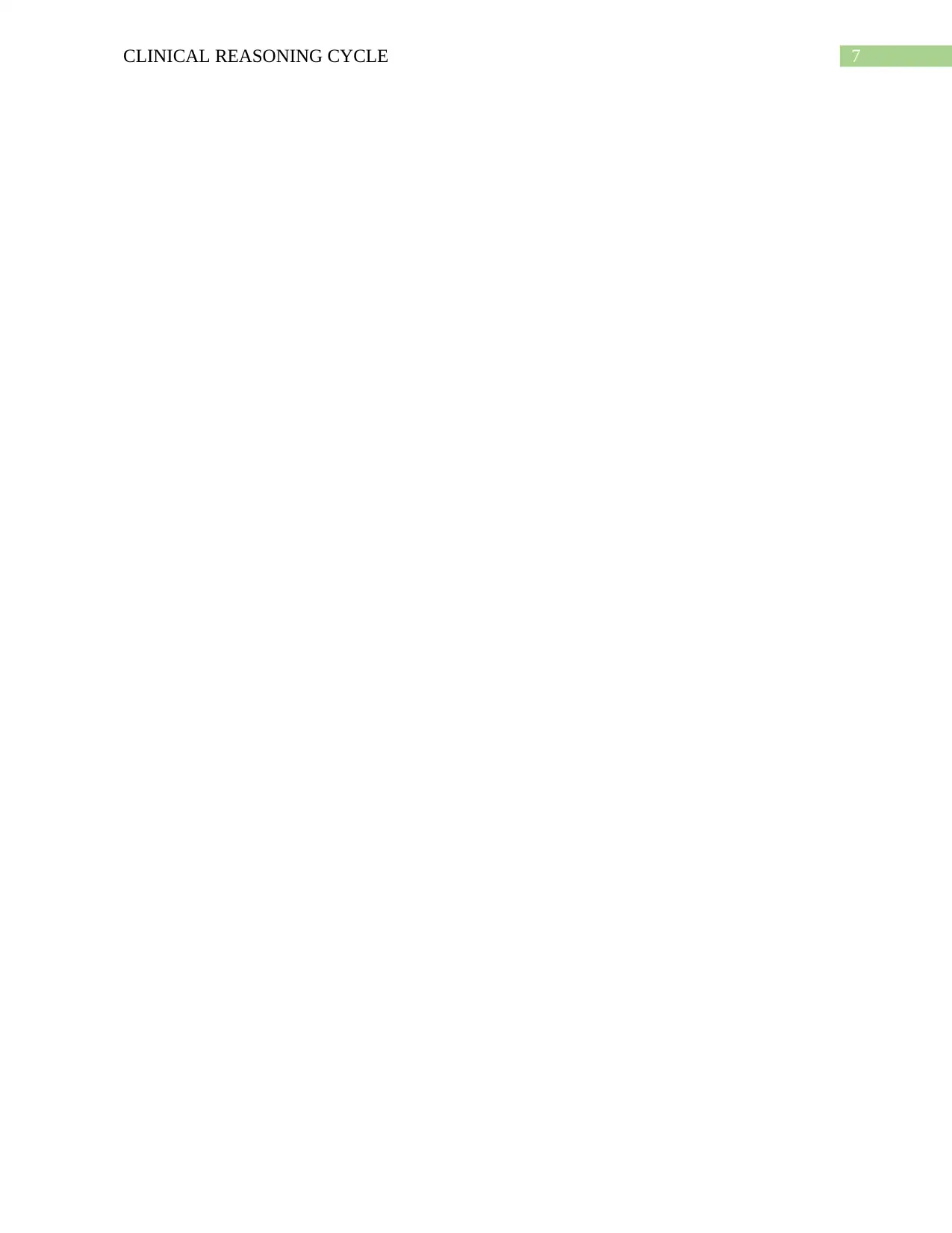
7CLINICAL REASONING CYCLE
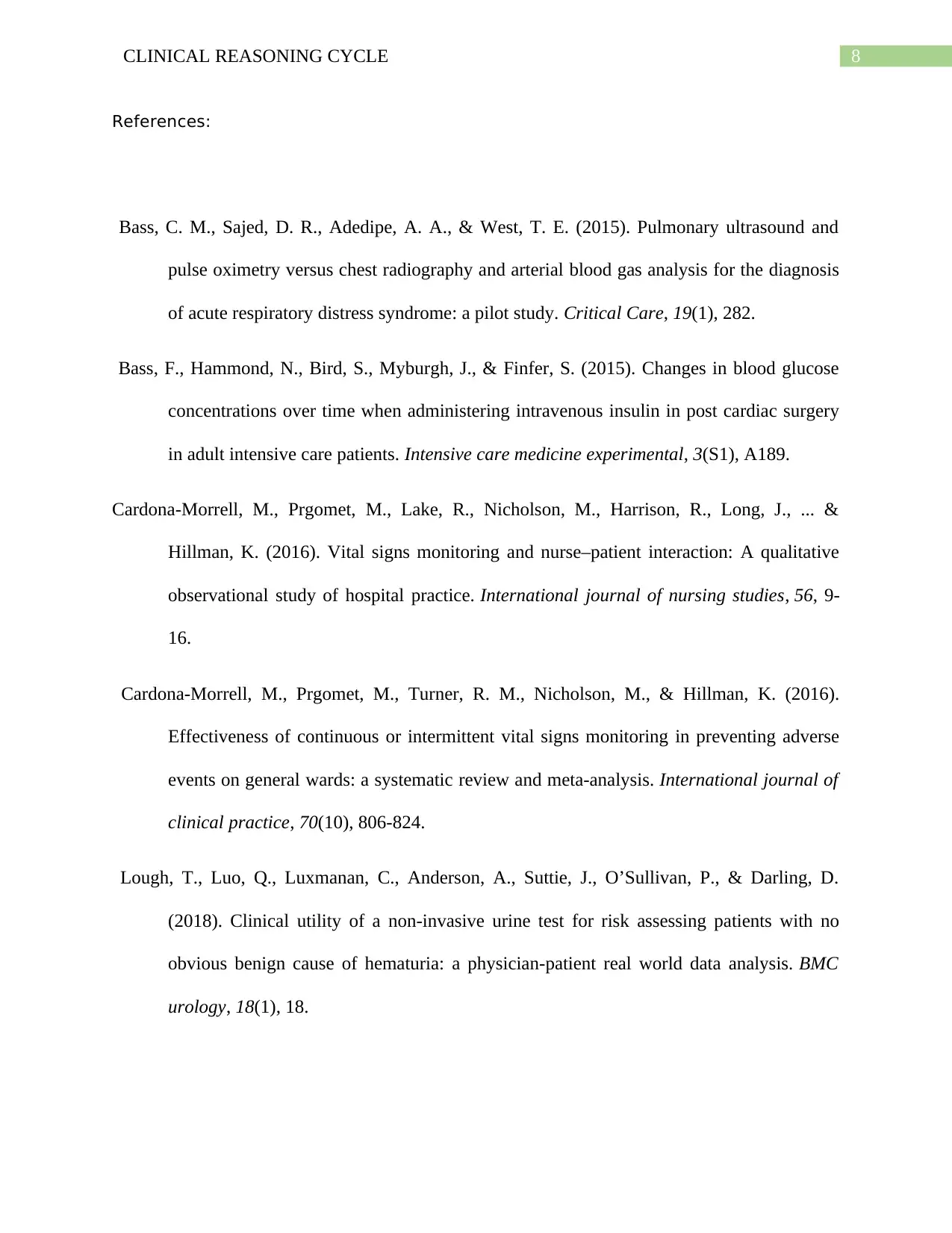
8CLINICAL REASONING CYCLE
References:
Bass, C. M., Sajed, D. R., Adedipe, A. A., & West, T. E. (2015). Pulmonary ultrasound and
pulse oximetry versus chest radiography and arterial blood gas analysis for the diagnosis
of acute respiratory distress syndrome: a pilot study. Critical Care, 19(1), 282.
Bass, F., Hammond, N., Bird, S., Myburgh, J., & Finfer, S. (2015). Changes in blood glucose
concentrations over time when administering intravenous insulin in post cardiac surgery
in adult intensive care patients. Intensive care medicine experimental, 3(S1), A189.
Cardona-Morrell, M., Prgomet, M., Lake, R., Nicholson, M., Harrison, R., Long, J., ... &
Hillman, K. (2016). Vital signs monitoring and nurse–patient interaction: A qualitative
observational study of hospital practice. International journal of nursing studies, 56, 9-
16.
Cardona‐Morrell, M., Prgomet, M., Turner, R. M., Nicholson, M., & Hillman, K. (2016).
Effectiveness of continuous or intermittent vital signs monitoring in preventing adverse
events on general wards: a systematic review and meta‐analysis. International journal of
clinical practice, 70(10), 806-824.
Lough, T., Luo, Q., Luxmanan, C., Anderson, A., Suttie, J., O’Sullivan, P., & Darling, D.
(2018). Clinical utility of a non-invasive urine test for risk assessing patients with no
obvious benign cause of hematuria: a physician-patient real world data analysis. BMC
urology, 18(1), 18.
References:
Bass, C. M., Sajed, D. R., Adedipe, A. A., & West, T. E. (2015). Pulmonary ultrasound and
pulse oximetry versus chest radiography and arterial blood gas analysis for the diagnosis
of acute respiratory distress syndrome: a pilot study. Critical Care, 19(1), 282.
Bass, F., Hammond, N., Bird, S., Myburgh, J., & Finfer, S. (2015). Changes in blood glucose
concentrations over time when administering intravenous insulin in post cardiac surgery
in adult intensive care patients. Intensive care medicine experimental, 3(S1), A189.
Cardona-Morrell, M., Prgomet, M., Lake, R., Nicholson, M., Harrison, R., Long, J., ... &
Hillman, K. (2016). Vital signs monitoring and nurse–patient interaction: A qualitative
observational study of hospital practice. International journal of nursing studies, 56, 9-
16.
Cardona‐Morrell, M., Prgomet, M., Turner, R. M., Nicholson, M., & Hillman, K. (2016).
Effectiveness of continuous or intermittent vital signs monitoring in preventing adverse
events on general wards: a systematic review and meta‐analysis. International journal of
clinical practice, 70(10), 806-824.
Lough, T., Luo, Q., Luxmanan, C., Anderson, A., Suttie, J., O’Sullivan, P., & Darling, D.
(2018). Clinical utility of a non-invasive urine test for risk assessing patients with no
obvious benign cause of hematuria: a physician-patient real world data analysis. BMC
urology, 18(1), 18.
⊘ This is a preview!⊘
Do you want full access?
Subscribe today to unlock all pages.

Trusted by 1+ million students worldwide
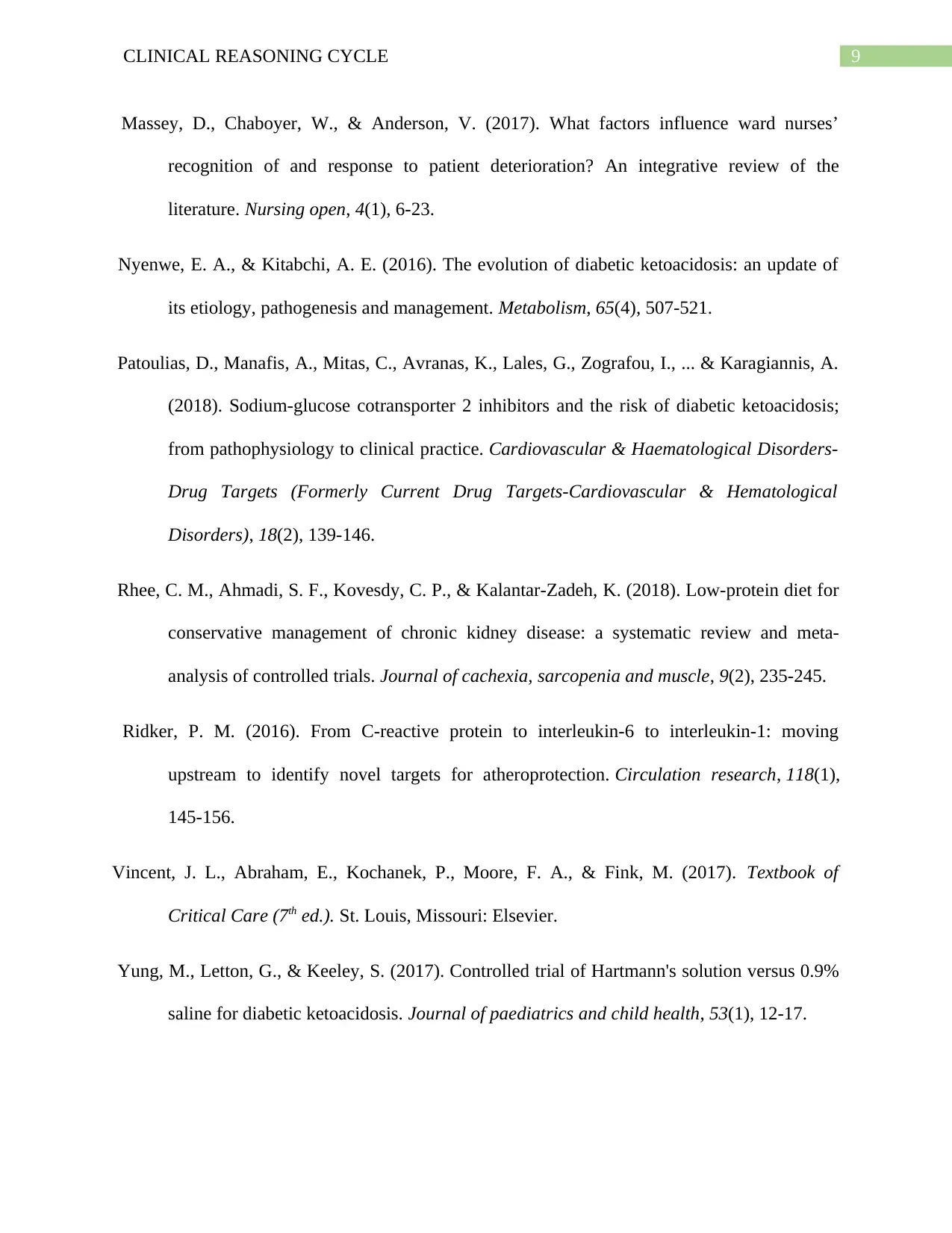
9CLINICAL REASONING CYCLE
Massey, D., Chaboyer, W., & Anderson, V. (2017). What factors influence ward nurses’
recognition of and response to patient deterioration? An integrative review of the
literature. Nursing open, 4(1), 6-23.
Nyenwe, E. A., & Kitabchi, A. E. (2016). The evolution of diabetic ketoacidosis: an update of
its etiology, pathogenesis and management. Metabolism, 65(4), 507-521.
Patoulias, D., Manafis, A., Mitas, C., Avranas, K., Lales, G., Zografou, I., ... & Karagiannis, A.
(2018). Sodium-glucose cotransporter 2 inhibitors and the risk of diabetic ketoacidosis;
from pathophysiology to clinical practice. Cardiovascular & Haematological Disorders-
Drug Targets (Formerly Current Drug Targets-Cardiovascular & Hematological
Disorders), 18(2), 139-146.
Rhee, C. M., Ahmadi, S. F., Kovesdy, C. P., & Kalantar‐Zadeh, K. (2018). Low‐protein diet for
conservative management of chronic kidney disease: a systematic review and meta‐
analysis of controlled trials. Journal of cachexia, sarcopenia and muscle, 9(2), 235-245.
Ridker, P. M. (2016). From C-reactive protein to interleukin-6 to interleukin-1: moving
upstream to identify novel targets for atheroprotection. Circulation research, 118(1),
145-156.
Vincent, J. L., Abraham, E., Kochanek, P., Moore, F. A., & Fink, M. (2017). Textbook of
Critical Care (7th ed.). St. Louis, Missouri: Elsevier.
Yung, M., Letton, G., & Keeley, S. (2017). Controlled trial of Hartmann's solution versus 0.9%
saline for diabetic ketoacidosis. Journal of paediatrics and child health, 53(1), 12-17.
Massey, D., Chaboyer, W., & Anderson, V. (2017). What factors influence ward nurses’
recognition of and response to patient deterioration? An integrative review of the
literature. Nursing open, 4(1), 6-23.
Nyenwe, E. A., & Kitabchi, A. E. (2016). The evolution of diabetic ketoacidosis: an update of
its etiology, pathogenesis and management. Metabolism, 65(4), 507-521.
Patoulias, D., Manafis, A., Mitas, C., Avranas, K., Lales, G., Zografou, I., ... & Karagiannis, A.
(2018). Sodium-glucose cotransporter 2 inhibitors and the risk of diabetic ketoacidosis;
from pathophysiology to clinical practice. Cardiovascular & Haematological Disorders-
Drug Targets (Formerly Current Drug Targets-Cardiovascular & Hematological
Disorders), 18(2), 139-146.
Rhee, C. M., Ahmadi, S. F., Kovesdy, C. P., & Kalantar‐Zadeh, K. (2018). Low‐protein diet for
conservative management of chronic kidney disease: a systematic review and meta‐
analysis of controlled trials. Journal of cachexia, sarcopenia and muscle, 9(2), 235-245.
Ridker, P. M. (2016). From C-reactive protein to interleukin-6 to interleukin-1: moving
upstream to identify novel targets for atheroprotection. Circulation research, 118(1),
145-156.
Vincent, J. L., Abraham, E., Kochanek, P., Moore, F. A., & Fink, M. (2017). Textbook of
Critical Care (7th ed.). St. Louis, Missouri: Elsevier.
Yung, M., Letton, G., & Keeley, S. (2017). Controlled trial of Hartmann's solution versus 0.9%
saline for diabetic ketoacidosis. Journal of paediatrics and child health, 53(1), 12-17.
Paraphrase This Document
Need a fresh take? Get an instant paraphrase of this document with our AI Paraphraser
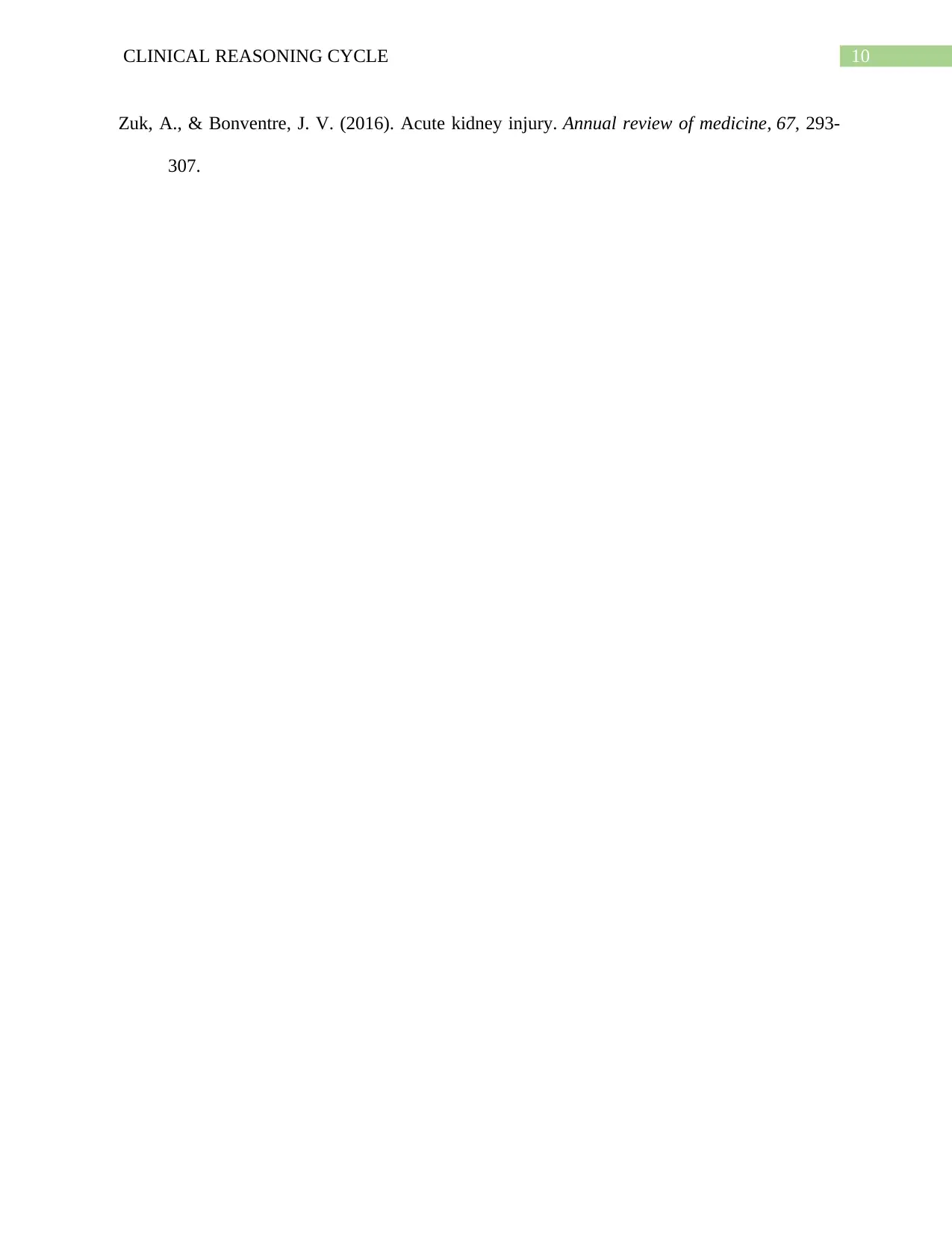
10CLINICAL REASONING CYCLE
Zuk, A., & Bonventre, J. V. (2016). Acute kidney injury. Annual review of medicine, 67, 293-
307.
Zuk, A., & Bonventre, J. V. (2016). Acute kidney injury. Annual review of medicine, 67, 293-
307.
1 out of 11
Related Documents
Your All-in-One AI-Powered Toolkit for Academic Success.
+13062052269
info@desklib.com
Available 24*7 on WhatsApp / Email
![[object Object]](/_next/static/media/star-bottom.7253800d.svg)
Unlock your academic potential
Copyright © 2020–2025 A2Z Services. All Rights Reserved. Developed and managed by ZUCOL.





